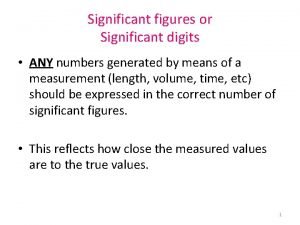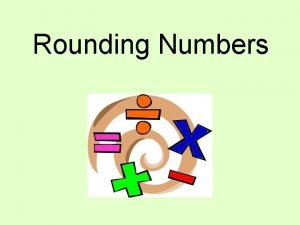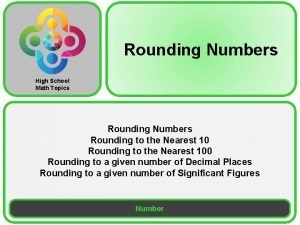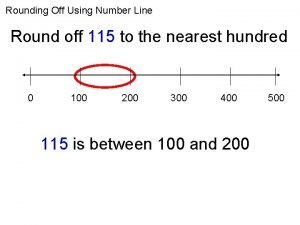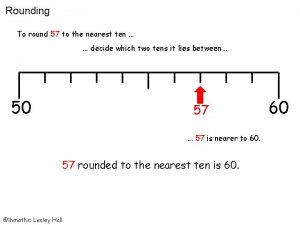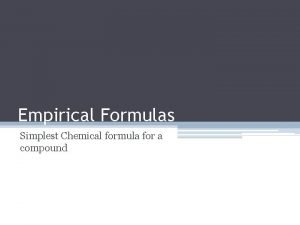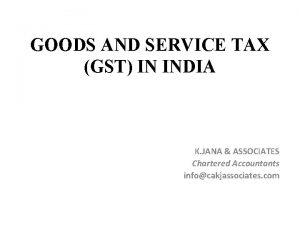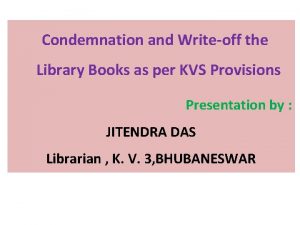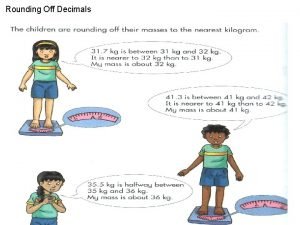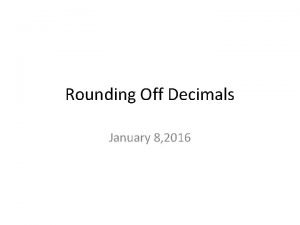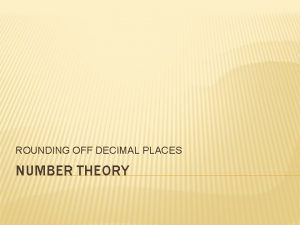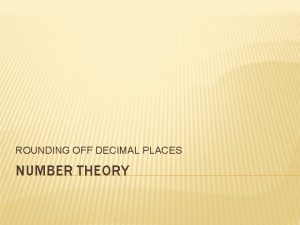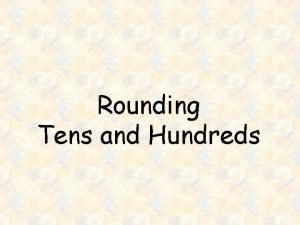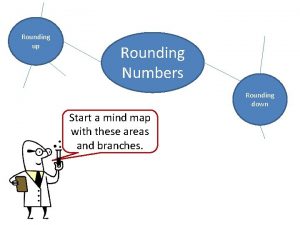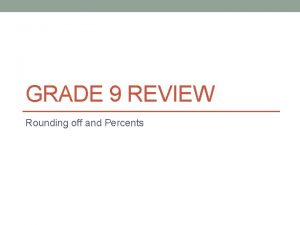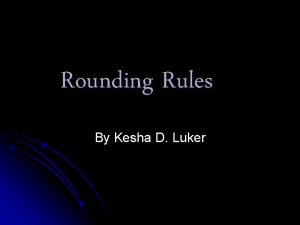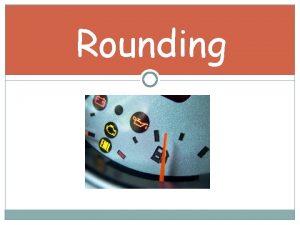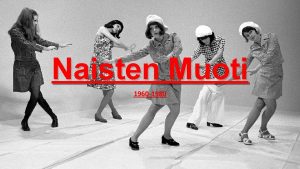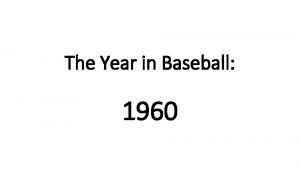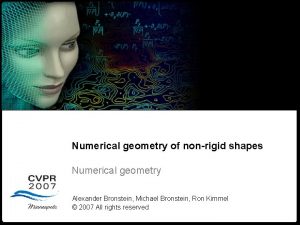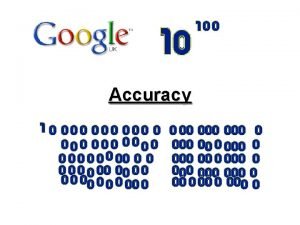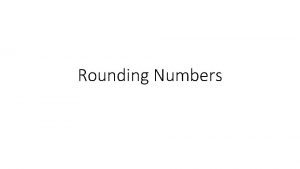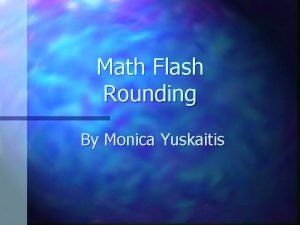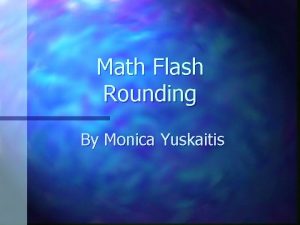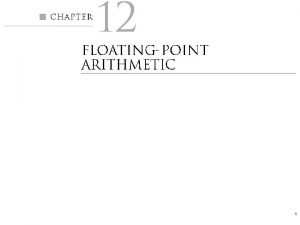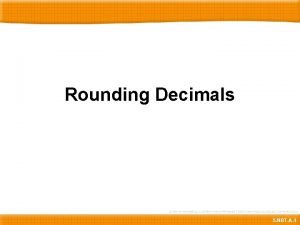IS 2 1960 RULES FOR ROUNDING OFF NUMERICAL

































- Slides: 33

IS 2 : 1960 RULES FOR ROUNDING OFF NUMERICAL VALUES

Retain a certain number of figures, counted from the left, and drop the others so as to give a more rational form to the value. As the result of a test or of a calculation is generally rounded off for the purpose of reporting or for drafting specifications, it is necessary to prescribe rules for ‘rounding off’ numerical values as also for deciding on ‘the number of figures’ to be retained

TERMINOLOGY 2. 1 Number of Decimal Places — A value is said to have as many decimal places as there are number of figures in the value, counting from the first figure after the decimal point and ending with the last figure on the right. Examples: Value 0. 029 50 21. 029 5 2 000 001 291. 00 10. 32 × 103 (see Note 1 ) Decimal Places 5 4 6 2 2

NOTE 1 — For the purpose of this standard, the expression 10. 32 × 103 should be taken to consist of two parts, the value proper which is 10. 32 and the unit of expression for the value, 103. 2. 2 Number of Significant Figures — A value is said to have as many significant figures as there are number of significant digits in the value, counting from the leftmost non-zero digit and ending with the right-most digit in the value.

Examples: Value 0. 029 500 0. 029 5 10. 029 5 2 000 001 5 677. 0 567 700 56. 77 × 102 0 056. 770 3 900 ( see Note 3 ) Significant Figures 5 3 6 10 5 6 4 5 4

NOTE 2 — Any of the digits, 1, 2, 3, . . . 9 occurring in a value shall be a significant digit (s); and zero shall be a significant digit only when it is preceded by some other digit (excepting zeros) on its left. When appearing in the power of 10 to indicate the magnitude of the unit in the expression of a value, zero shall not be a significant digit. NOTE 3 — For removing any ambiguity regarding the significance of the zeros at the end in a value like 3 900, it would be desirable to write the value in the power-of-ten notation. E. g. , 3 900 may be written as 3. 9 × 103, 3. 90 × 103 or 3. 900 × 103 depending upon the last figure (s) in the value to which it is desired to impart significance.

2. 3 Fineness of Rounding — The unit to which a value is rounded off. For example, a value may be rounded to the nearest 0. 000 01, 0. 000 2, 0. 000 5, 0. 001, 0. 002 5, 0. 005, 0. 01, 0. 07, 1, 2. 5, 10, 20, 50, 100 or any other unit depending on the fineness desired.

RULES FOR ROUNDING OFF 3. 1 Rounding Off to Unit Fineness - In case the fineness of rounding is unity in the last place retained, the following rules (except in 3. 4) shall be followed: Rule I When the figure next beyond the last figure or place to be retained is less than 5, the figure in the last place retained shall be left unchanged. E. g. 14. 22, 1 fineness, 14 ,

Rule II — When the figure next beyond the last figure or place to be retained is more than 5 or is 5 followed by any figures other than zeros, the figure in the last place retained shall be increased by 1. E. g. 14. 76, 1 fineness, 15 Rule III — When the figure next beyond the last figure or place to be retained is 5 alone or 5 followed by zeros only, the figure in the last place retained shall be (a) increased by 1 if it is odd and (b) left unchanged if even (zero would be regarded as an even number for this purpose). E. g. 14. 725, 3. 455; 0. 01 fineness, 14. 72, 3. 46

3. 1. 1 These rules for rounding in 3. 1 may be applied when the fineness of rounding is unity i. e. 0. 10, 100, 1000, etc. 3. 2 Rounding Off to Fineness Other than Unity — In case the fineness of rounding is not unity, but, say, it is n, the given value shall be rounded off according to the following rule:

Rule IV When rounding to a fineness n, other than unity, the given value shall be divided by n. The quotient shall be rounded off to the nearest whole number in accordance with the rules laid down in 3. 1 for unit fineness of rounding. The number so obtained, that is the rounded quotient, shall then be multiplied by n to get the final rounded value.

Value Fineness Quotient/ of Rounded Rounding Quotient Final Value 1. 6478 0. 2 1. 6 2. 4968 0. 3 325 50 8. 239 8 8. 3227 8 6. 5 6 2. 4 3 X 10²

3. 2. 1 Fineness of rounding other than 2 and 5 is seldom called for in practice. For these cases, the rules for rounding may be stated in simpler form as follows: a)Rounding Off to fineness 50, 5, 0. 05, 0. 005, etc. Rule V —When rounding to 5 units, the given value shall be doubled and rounded off to twice the required fineness of rounding in accordance with 3. 1. 1. The value thus obtained shall be halved to get the final rounded value. For example, in rounding off 975 to the nearest 50, 975 is doubled giving 1 950 which becomes 2 000 when rounded off to the nearest 100; when 2 000 is divided by 2, the resulting number 1 000 is the rounded value of 975.

b) Rounding off to fineness 20, 2, 0. 02, 0. 002, etc. Rule VI —When rounding to 2 units, the given value shall be halved and rounded off to half the required fineness of rounding in accordance with 3. 1. The value thus obtained shall then be doubled to get the final rounded value. For example, in rounding off 2. 70 to the nearest 0. 2, 2. 70 is halved giving 1. 35 which becomes 1. 4 when rounded off to the nearest 0. 1; when 1. 4 is doubled, the resulting number 2. 8 is the rounded value.

3. 3 Successive Rounding — The final rounded value shall be obtained from the most precise value available in one step only and not from a series of successive rounding. For example, the value 0. 549 9, when rounded to one significant figure, shall be written as 0. 5 and not as 0. 6 which is obtained as a result of successive rounding to 0. 550, 0. 55, and 0. 6. It is obvious that the most precise value available is nearer to 0. 5 and not to 0. 6 and that the error involved is less in the former case.

NOTE 5 — In those cases where a final rounded value terminates with 5 and it is intended to use it in further computation, it may be helpful to use a ‘+’ or ‘–’ sign after the final 5 to indicate whether a subsequent rounding should be up or down. Thus 3. 214 7 may be written as 3. 215– when rounded to a fineness of rounding 0. 001.

Similarly, 3. 205 4 could be written as 3. 205+ when rounded to 4 significant figures. Further rounding to 3 significant figures would yield the value as 3. 21. In case the final 5 is obtained exactly, it would be indicated by leaving the 5 as such without using ‘+’ or ‘–’ sign. In subsequent rounding the 5 would then be treated in accordance with Rule III.

3. 4 The rules given in 3. 1, 3. 2 and 3. 3 should be used only if no specific criteria for the selection of the rounded number have to be taken into account. In all cases, where safety requirements or prescribed limits have to be respected, rounding off should be done in one direction only.

Exercise i) Max leakage current specified is 210 µA Test Result obtained is 210. 1 ii) Requirement of Cyanide for drinking water is 0. 05 mg/l Max Test result 0. 051 mg/l iii) Min thickness of the body of LPG Cylinder is 2. 4 mm Test result 2. 39 mm

NUMBER OF FIGURES TO BE RETAINED 4. 1 Experimental Results — The number of figures to be retained in an experimental result, either for the purpose of reporting or for guiding the formulation of specifications will depend on the significance of the figures in the value.

4. 2 Computations — In computations involving values of different accuracies, the problem as to how many figures should be retained at various steps assumes a special significance as it would affect the accuracy of the final result. The rounding off error will, in fact, be injected into computation every time an arithmetical operation is performed. It is, therefore, necessary to carry out the computation in such a manner as would obtain accurate results consistent with the accuracy of the data in hand.

4. 2. 1 While it is not possible to prescribe details which may be followed in computations of various types, certain basic rules may be recommended for single arithmetical operations which, when followed, will save labour and at the same time enable accuracy of original data to be normally maintained in the final answers.

a) Addition—The more accurate values shall be rounded off so as to retain one more place than the last significant figure in the least accurate value. The resulting sum shall then be rounded off to the last significant place in the least accurate value. b) Subtraction—The more accurate value (of the two given values) shall be rounded off, before subtraction, to the same place as the last significant figure in less accurate value; and the result shall be reported as such. c) Multiplication and Division —The number of significant figures retained in the more accurate values shall be kept one more than that in the least accurate value. The result shall then be rounded off to the same number of significant figures as in the least accurate value.

d) When a long computation is carried out in several steps, the intermediate results shall be properly rounded at the end of each step so as to avoid the accumulation of rounding errors in such cases. It is recommended that, at the end of each step, one more significant figure may be retained than is required under (a), (b) and (c). NOTE 6 — The loss of the significant figures in the subtraction of two nearly equal values is the greatest source of inaccuracy in most computations, and it forms the weakest link in a chain computation where it occurs. Thus, if the values 0. 169 52 and 0. 168 71 are each correct to five significant figures, their difference 0. 000 81, which has only two significant figures, is quite likely to introduce inaccuracy in subsequent computation.

If, however, the difference of two values is desired to be correct to k significant figures and if it is known beforehand that the first m significant figures at the left will disappear by subtraction, then the number of significant figures to be retained in each of the values shall be m + k.

4. 2. 3 Examples Example Required to find the sum of the rounded off values 461. 32, 381. 6, 76. 854 and 4. 746 2. Since the least accurate value 381. 6 is known only to the first decimal place, all other values shall be rounded off to one more place, that is, to two decimal places and then added as 924. 52. The resulting sum shall then be reported to the same decimal place as in the least accurate value, that is, as 924. 5.

Example Required to find the difference of 679. 8 and 76. 365, assuming that each number is known to its last figure but no farther. Since one of the values is known to the first decimal place only, the other value shall also be rounded off to the first decimal place as 76. 4 and then the difference shall be found. The difference, 603. 4, shall be reported as such.

Example Required to evaluate √ 2. 52 - √ 2. 49 correct to five significant figures. Since √ 2. 52= 1. 587 450 79 √ 2. 49 = 1. 577 973 38 and three significant figures at the left will disappear on subtraction, the number of significant figures retained in each value shall be 8. The result, 0. 009 477 4, shall be reported as such (or as 9. 477 4 × 10– 3).

Example Required to evaluate 35. 2/ √ 2 given that the numerator is correct to its last figure. Since the numerator here is correct to three significant figures, the denominator shall be taken as √ 2 = 1. 414. Then, 35. 2/1. 414 = 24. 89, and the result shall be reported as 24. 9.

Example Required to evaluate 3. 78π/5. 7, assuming that the denominator is true to only two significant figures. Since the denominator here is correct to two significant figures, each number in the numerator would be taken up to three significant figures. Thus, 3. 78 x 3. 14 = 2. 08 5. 7 The result shall be reported as 2. 1

A-1. The validity of the rules for rounding off numerical values, as given in 3. 1, may be seen from the fact that to every number that is to be ‘rounded down’ in accordance with Rule I, there corresponds a number that is to be ‘rounded up’ in accordance with Rule II. Thus, these two rules establish a balance between rounding ‘down’ and ‘up’ for all numbers other than those that fall exactly midway between two alternatives. In the latter case, since the figure to be dropped is exactly 5, Rule III, which specifies that the value should be rounded to its nearest even number, implies that rounding shall be ‘up’ when the preceding figures are 1, 3, 5, 7, 9 and ‘down’ when they are 0, 2, 4, 6, 8.

Rule III, hence, advocates a similar balance between rounding ‘up’ and ‘down’. This implies that if the above rules are followed in a large group of values in which random distribution of figures occurs, the number ‘rounded up’ and the number ‘rounded down’ will be nearly equal. Therefore, the sum and the average of the rounded values will be more nearly correct than would be the case if all were rounded in the same direction, that is, either all ‘up’ or all ‘down’.

THANK YOU
 Round off rule of 5
Round off rule of 5 Rounding numbers 5
Rounding numbers 5 Rounding to two decimal places
Rounding to two decimal places 115 rounded to the nearest ten
115 rounded to the nearest ten Ten thousand
Ten thousand Rounding off 100
Rounding off 100 Nearest metre
Nearest metre Rounding off poem
Rounding off poem Scientific figures
Scientific figures Writing empirical formula
Writing empirical formula Elbows off the table fingers off the food song
Elbows off the table fingers off the food song Ice hockey face off rules
Ice hockey face off rules I gst
I gst Condemnation report sample
Condemnation report sample Iso 22301 utbildning
Iso 22301 utbildning Typiska drag för en novell
Typiska drag för en novell Nationell inriktning för artificiell intelligens
Nationell inriktning för artificiell intelligens Ekologiskt fotavtryck
Ekologiskt fotavtryck Varför kallas perioden 1918-1939 för mellankrigstiden
Varför kallas perioden 1918-1939 för mellankrigstiden En lathund för arbete med kontinuitetshantering
En lathund för arbete med kontinuitetshantering Särskild löneskatt för pensionskostnader
Särskild löneskatt för pensionskostnader Tidbok
Tidbok Sura för anatom
Sura för anatom Vad är densitet
Vad är densitet Datorkunskap för nybörjare
Datorkunskap för nybörjare Boverket ka
Boverket ka Debattartikel mall
Debattartikel mall Autokratiskt ledarskap
Autokratiskt ledarskap Nyckelkompetenser för livslångt lärande
Nyckelkompetenser för livslångt lärande Påbyggnader för flakfordon
Påbyggnader för flakfordon Vätsketryck formel
Vätsketryck formel Svenskt ramverk för digital samverkan
Svenskt ramverk för digital samverkan Jag har gått inunder stjärnor text
Jag har gått inunder stjärnor text Presentera för publik crossboss
Presentera för publik crossboss
